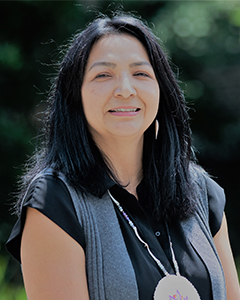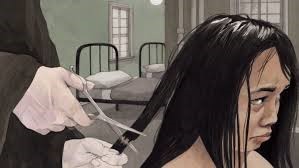#boyswithbraids #BWB

Paula Hedgepeth - Special Projects Coordinator (Indigenous Initiatives) Western University
Paula is a Haudenosaunee woman from the Oneida Nation of the Thames First Nation and of the Wolf Clan. She works in education, most recently at the Greater Essex County District School Board, in the area of Indigenous initiatives.
Paula earned bachelor’s degrees in History and Education from the University of Windsor, and is a graduate of Western’s Masters in Professional Education and Indigenous Leadership. She is also a member of the Ontario College of Teachers.
I have chosen to write about a deeply personal topic – the bullying experiences of Indigenous boys with braids in mainstream schooling settings. I write about this topic as an Indigenous mother of two children a young man, and a boy who have long hair, but have endured the bullying and violence perpetrated by other kids on the playground - forms of violence deeply embedded within white settler masculinist norms based on assumptions of what a ‘real boy’ should look like. As we have learned, being an Indigenous boy with long hair in our day and age has real consequences.
I recognize that I am not a man, nor do I embody the lived experiences that Indigenous boys with braids face as they courageously wear long hair for cultural reasons in a white settler society. I recognize myself as a cisgender woman from the Haudenosaunee peoples, specifically the local Onyota:aka Nation. I am a mother and I have born witness to my sons’ struggle wearing long hair in a contemporary world.
I recognize that this contemporary reality is deeply connected to our colonial past and ongoing present. I grew up in the pre-Truth and Reconciliation Commission (TRC). I was born in 1971 in southwestern Ontario, and while the closest residential school to my home community closed in 1946, the colonial and assimilationist school system transitioned to a day school and then later a public school format. In many ways, colonial ideologies associated with being a ‘real man’ live on in today’s hidden hegemonic ideologies and dominant curriculum.
As a result of our inherently colonial education system, my Oneida language and culture was not part of my educational learning, and the violent experiences of my grandparents and parents were passed on to me inter-generationally. While my grandparents still spoke our Oneida language and remembered our Oneida ways, they did not pass these onto me as a child, because they were socially conditioned in educational settings to believe that our language and ways of knowing were useless in the modern world. All my life, I have felt a deep sense of grief and loss associated with this colonial conditioning. I did not realize that something was missing until these losses began manifesting in my day-to-day actions, my self-appreciation, self-love, self-everything.
My first son was born in 2000. His birth gave me a firm push toward reclaiming my identity and culture. What I knew was that I wanted my son to know who he was as an Oneida, Unkwehuwe. I actively pursued reclaiming our culture, Longhouse, powwow, history and political life– everything that I could learn or immerse myself and my family in, I took up with fervor. Of those, long hair was a way that my husband and I reclaimed our ways of being. My husband decided to grow his hair long and we chose to keep our sons hair long as well, no hair cuts.
This seemingly natural decision led to many unexpected revelations where our Indigenous cultural reclamation, Indigenous pride, spirituality and ways of being and knowing became deeply relevant in our daily lives. Wearing long hair was a daily reminder for ourselves and others that we are connected to the land. Unfortunately, along with this lived reality came many misunderstandings, misidentification, confusion and blatant disturbing comments from those who do not understand our ways or agree that boys should wear long hair. These colonial attitudes were pervasive from both non-Indigenous and Indigenous peoples alike.
My purpose for writing this blog is to incite dialogue about this important topic. In 2010, a grassroots movement started by Michael Linklater (Cree) has also contributed to this dialogue by giving voice to Indigenous boys with braids in efforts to raise awareness and educate people. My eldest son is now 20 years old, and my youngest son is 12. Interestingly, my youngest son still deals with the same comments and issues that Michael Linklater dealt with as a child, and which his own children have endured, and my children continue to face.
Walking into new situations for my sons has always been a point of anxiety, because they inevitably have to face the assumptions and imminent comments and actions of others. There are so many instances that I could name, but one that truly breaks my heart is the issue of using male bathrooms without torment. In school up to this very past year, my youngest son would avoid using the bathroom for the entire day or at least be very cautious about when he would use the bathroom. He figured out patterns of when the bathroom was likely to be empty. Seemingly harmless assumptions such as ‘are you in the wrong washroom?’ are just as harmful as ‘what are you doing in here? You’re a girl’!’ There are also the incessant non-verbal stares, which create self-consciousness which no child should have to deal with when simply relieving themselves. Admittedly, I weakened and I asked my son if he wanted to cut his hair? I wanted to make his life easier and I felt cutting his hair could help. He bravely declined. In retrospect, I regret asking him that question or even having the thought, because what I essentially succumbed to was white settler fragility. I found myself so desperate that I was willing to accommodate non-Indigenous discomforts with our Indigeneity. I was putting non-Indigenous peoples’ values and comforts with long hair ahead of our own. My son is proud of his hair and I am so thankful that he is strong and resilient, but he is only a young boy and our society needs to do better. Sadly, he still feels the need to tuck his braid into his shirt when using the men’s bathroom, because his braid makes many non-Indigenous people uncomfortable that they go so far as to comment and exclude him.

“I am not a number”, written by Jenny Kay Dupius & Kathy Kacer, illustrated by Gillian Newland – book cover
It can be helpful to contextualize the ways that the white settler colonial ideologies were embedded within the residential school system, which involved cutting the boys (and girls) long hair as a form of ethnic cleansing. The severance was among the first traumatic events to occur to Indigenous children upon arrival to these schools. Its purpose was to clean the ‘savage Indian’ and to embed binary gendered norms into Indigenous boys and girls. Girls hair was often cut short shoulder length and boys was cut shorter.
Today, a sad truth is that Indigenous boys with braids face bullying in schools. Somehow a beautiful braid down their back represents a bullseye for exclusion on the playground. As a mother, I have had to address this reality a few times with teachers on behalf of my sons. In my previous role as a First Nations educator in the K-12 system, I have also had to support several young Indigenous boys with braids deal with the associated feeling that accompany bullying and not looking a like ‘real boy’. I have born witness to Indigenous boys feeling so disempowered by the constant taunts, teasing, bullying and exclusion that they have decided to cut their braids just to be free from it. These truths bring me to tears. Why? Why do Indigenous boys need to cut their hair to feel included in certain educational spaces?
Many people do not realize the sense of cultural pride that my sons (and other Indigenous boys) have as a result of growing and keeping their hair long. Long hair represents a deep spiritual connection to the earth and our ways of being and knowing. My oldest son still fields the odd disrespectful comment. My youngest, while he has a school community that knows who he is as an Indigenous boy, a path paved by my oldest, still endures the daily ignorance in our society where he is referred to as ‘her, she, or a girl’ regularly. The thing is, it’s a battle they have to fight as an Indigenous boy with long hair, but it’s a battle that they should not have had to fight. At some point, we need to challenge the preconceived gendered notions and understandings that we have about what makes someone a boy or a girl. We have to challenge ourselves and young people to move beyond the binary and narrow girl/boy constructs.
In my generation, many Indigenous men grow their hair long as an act of cultural reclamation. It is deeply associated with their male gendered identity. By educating more people about the deep meaning of long hair among Indigenous men, I hope we create a less ignorant and more respectful society.
What I would like to leave you with is a deeper appreciation for the pride that develops, the strength nurtured and the courage that it must take for Indigenous boys to wear long hair. They have to field incessant questions, hear unwanted remarks and more often than not, be mistaken for a girl. What I would hope is that through awareness and education, we can become more culturally sensitive to the fact that Indigenous boys have long hair, they wear their hair in braids, or buns or just loose and it is still masculine. I would ask us to open our minds and be a bit less gender presumptuous when coming across anyone with long hair. We can always ask if we are not sure, because I assure you, as a mother of Indigenous boys with braids, I would much rather you ask me or him whether he is a boy or girl, in a respectful way, rather than assume that boys cannot have long hair. Asking shows respect for differences and a recognition that long hair does not equal girl!
Lastly, to educators of young boys with braids, JK to high school, please be cognizant of this issue. If you have an Indigenous boy who has chosen to reclaim this part of his identity, please know that it is a struggle. He most likely needs your support, and he needs you to create a safe space and understanding.
I am a proud mother of two Indigenous boys with braids.
